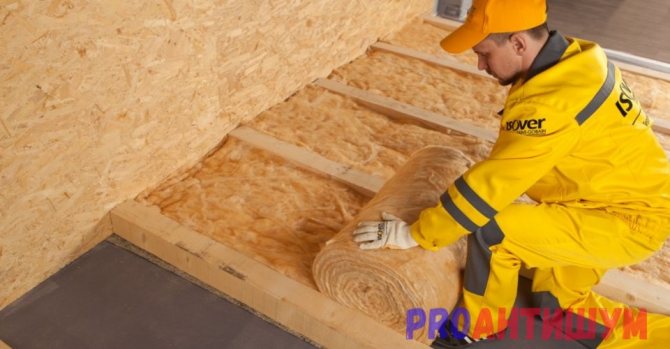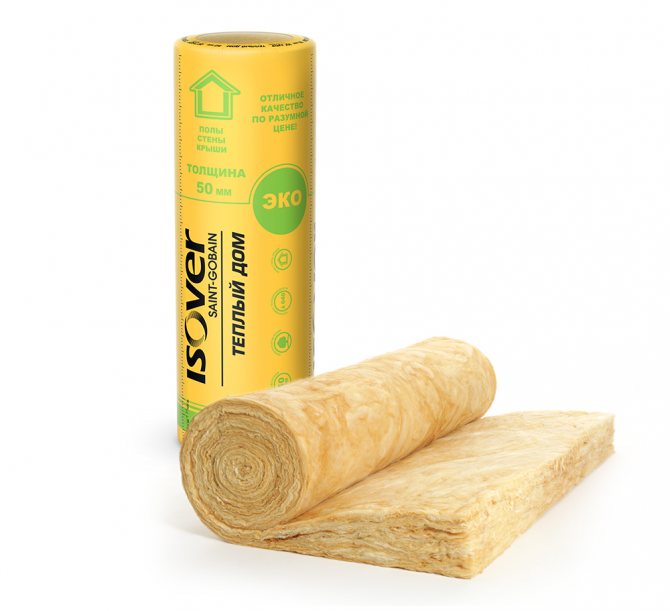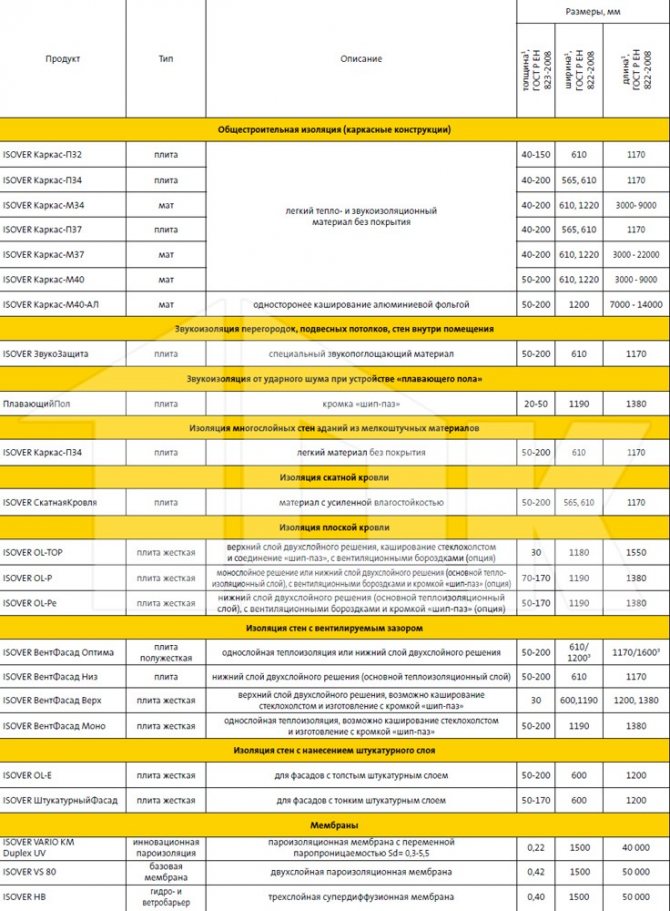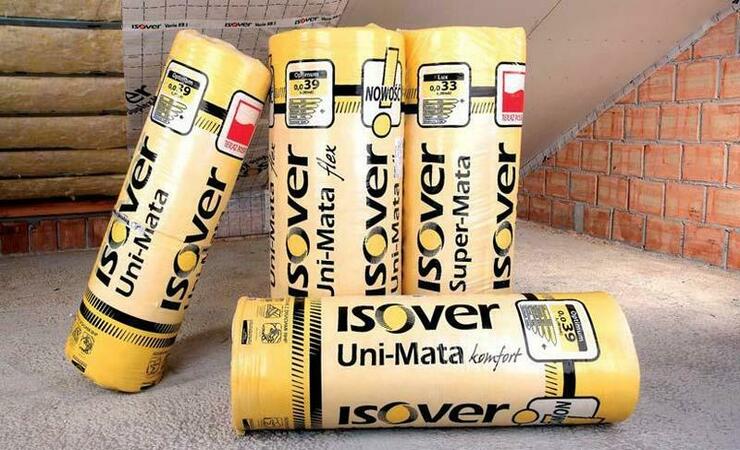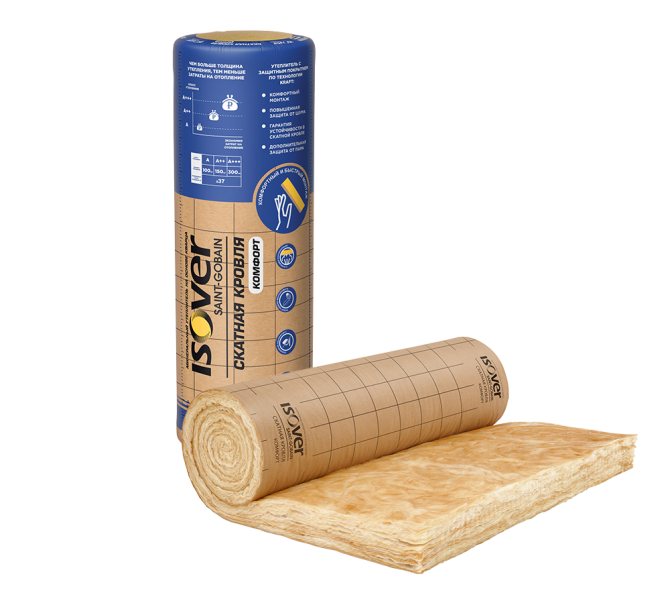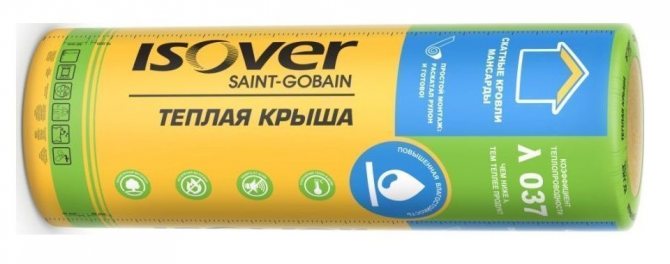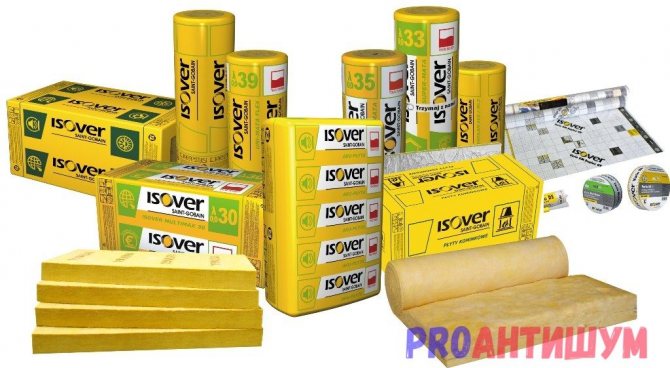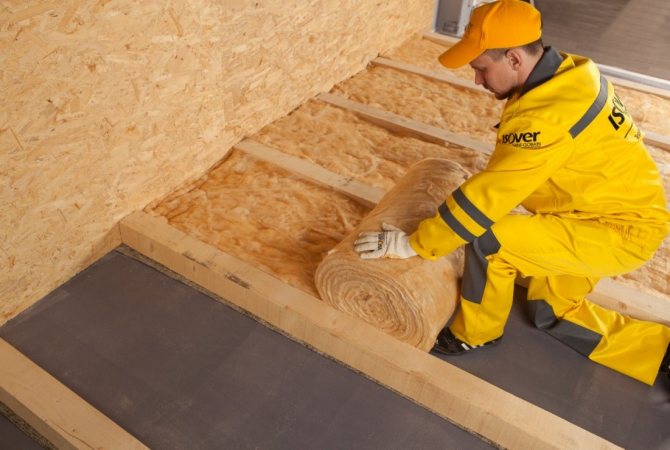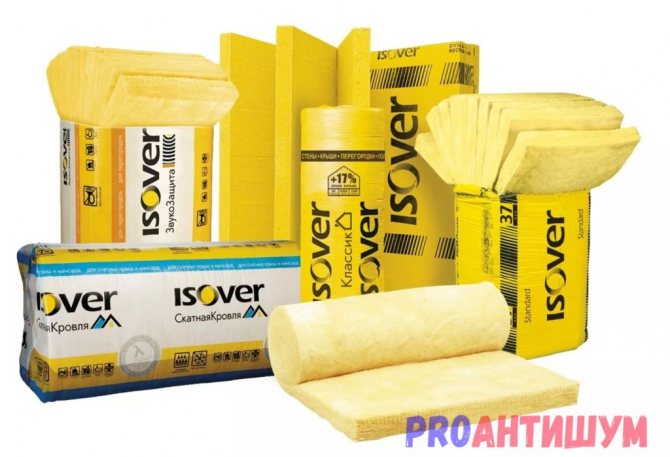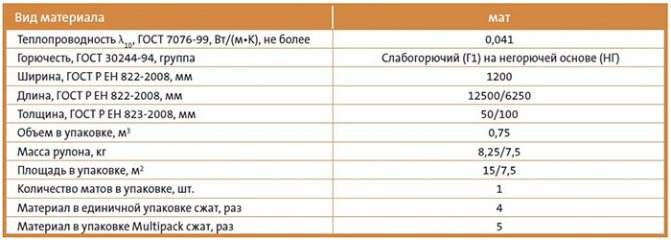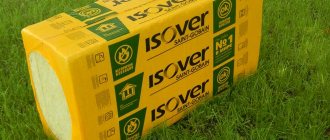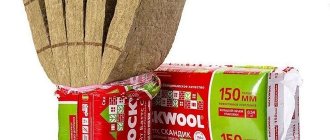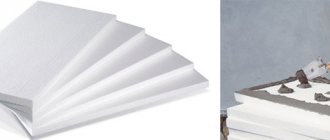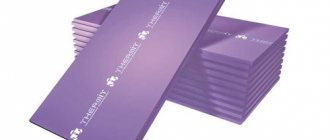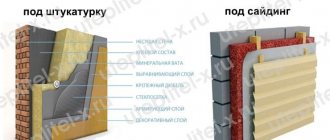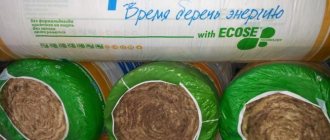Increasing the thermal protection of a private house during construction is an important stage of work, while significant volumes are insulated, and the cost of thermal insulation materials becomes a decisive factor. One of the popular inexpensive types of heat insulators is Isover insulation, the technical characteristics of which are excellent for use in individual housing construction.
It should be noted that Isover is a modern, more technological version of the classic glass wool, which was widely used in the Soviet period for thermal insulation of public pipelines for heating and hot water supply systems. Isover is produced in several modifications depending on the purpose, each brand in the series has different parameters, differs in the way of installation. Knowledge of the characteristics and varieties of Isover will help you choose the right product without overpayments, install it in compliance with the technological process, which is the main requirement for installing any type of insulation.

Izover - appearance
What is Isover, release form
The founder of the Isover brand is the international Saint-Gobain holding, whose roots were laid back in the 17th century, now the corporation includes more than 100 manufacturing companies and research centers conducting research in the construction industry. The company appeared on the Russian market 20 years ago; currently, a plant for the production of insulation works in the city of Yegoryevsk, Moscow Region. In 2011, the Saint-Gobain holding bought out the Chelyabinsk plant of Minvat, it has launched the production of insulation from stone fibers of mountain basalt.
Isover is obtained by processing sand (quartz), cullet, rock minerals (basalt), after melting the raw material in a high-temperature furnace, the mass is drawn into fibers using the TEL technology to obtain threads with a cross section of 4 - 5 microns and 110 - 150 microns in length.
Note: Saint-Gobain is the only manufacturer in the country with a patented crimping technology that allows the production of high mechanical strength fiberglass products.
Hard fiberglass is placed in slabs, soft fiber is rolled into mats and rolls, products differ in thickness and dimensional dimensions, depending on the purpose and production technology.
Typical thickness of one-layer or two-layer Izover is 50 - 100 - 150 mm, rolls are produced with a total area of 2 - 20 m2, their usual width is 1200 mm, length is from 4000 to 12000 mm. The area of one Isover slab does not exceed 1 m2, its overall dimensions are kept within the limits of 600x1200 mm, the number in a pack is from 2 to 14 pieces.
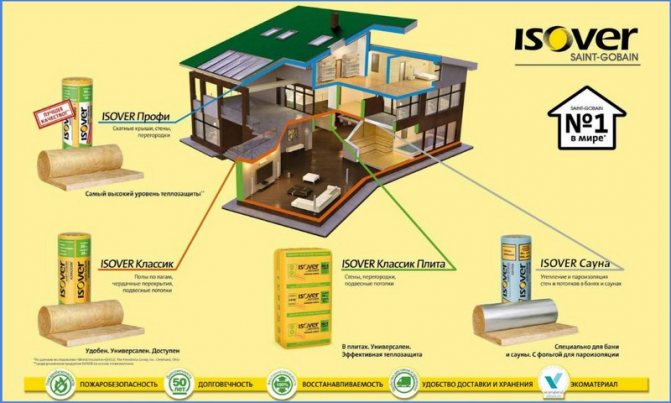

Insulation places of a private house
Brand history
The rights to the brand belong to the firm of Saint-Gobain from France. Its main office is located in Paris, and the date of its foundation is 1665. It appeared at the direction of Louis XIV and produced glass and mirrors. The name of the insulation Isover was formed from the words "glass" and "insulation". In our country, the company's products were initially known under the brand name "Uteplyaev".
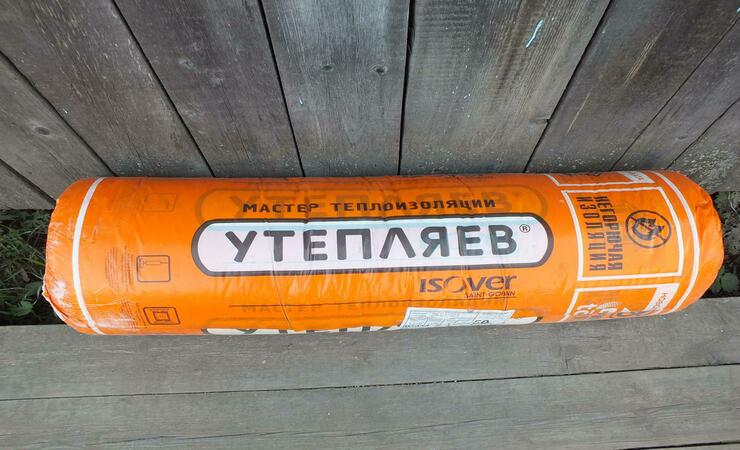

Initial production of Izover in Russia
For more than 350 years of history, Saint-Gobain has grown into an international industrial group, represented in 67 countries and with over 170 thousand employees. Sales in 2015 were € 39.6 billion. The company is included in the following ratings:
- 100 largest industrial enterprises according to Forbes.
- Top-100 innovative organizations in the construction sector.
- Best Employer - 2020
Experience and the latest technology have made the company a world leader in creating comfortable living spaces. The main activities of Saint-Gobain are:
- Innovative technologies in the field of high-tech products in the production of ordinary and special glass.
- Building materials represented by the brands ISOVER, ISOTEC, ISOROC in isolation; GYPROC in plaster solutions; dry mixes WEBER; ECOPHON for acoustic ceilings and panels; in siding and tiles - CERTAINTEED; PAM pipes.
- Distribution activity in the field of building materials.
Saint Gobain Campaign:
The company's products have been known on the Russian market for over 20 years. Ten years ago, a plant was opened in the Moscow region (Yegoryevsk), and since 2011 in Chelyabinsk, a stone fiber insulation has been produced at the Minvata plant. All products have international environmental certificates and comply not only with internal corporate standards, but also EN 13162 — ISO 9001.
Scope and characteristics of Izover
Heaters made of fiberglass and mineral wool are widely used in individual and civil housing construction, with their help they protect roofs, walls, ceilings, floors and partitions of cottages and country houses, baths and saunas from heat loss, insulate pipes for supplying hot water inside premises for heating and hot water supply, heat-insulate ventilation ducts, chimneys.
Isover has the following characteristics:
- Is a brand supplying rigid fiberglass boards with a tensile strength of 15 kPa and a compressive strength of 60 kPa.
- Minvats are produced from natural raw materials (quartz, basalt), therefore, they are environmentally friendly and harmless to human health, they have been assigned the EcoMaterial Absolute ecological group and the international certificate of environmental purity ISO 14001: 2004.
- The coefficient of thermal conductivity (CT) depends on the shape of the product and lies in the range of 0.03 - 0.045 W / (m • K), this indicator for glass wool is slightly higher than that of expanded polystyrene (foam) and basalt fiber.
- The vapor permeability of products is also related to the shape and has an indicator of 0.3 - 0.55 mg / m • h • Pa, the parameter indicates that the heat insulator passes air well.
- The noise reduction of a sheet of 100 mm is 45 - 55 dB, which means that glass wool has a high sound insulation.
- The moisture absorption coefficient of glass wool with incomplete immersion in water for 24 hours is 1% or 1 kg / m2, a material completely immersed in a liquid for 72 hours absorbs 10% of the liquid from its weight, while its thermal insulation properties drop sharply. To combat this phenomenon, water repellents with water-repellent qualities are introduced into the composition of the heat insulator.
- The density of Izover depends on the form of release (soft mats or hard sheets) and ranges from 11 to 155 kg / m3.
- Mineral wool is classified as non-combustible; in accordance with GOST 30244-94, they are assigned the NG flammability index.
- The operational service life of the Isovero mineral wool set by the manufacturer is 50 years without losing its physical and chemical properties.
- Mineral wool is biologically stable, prevents the formation of mold and bacterial colonies, insects do not like to multiply and be in the mineral environment.
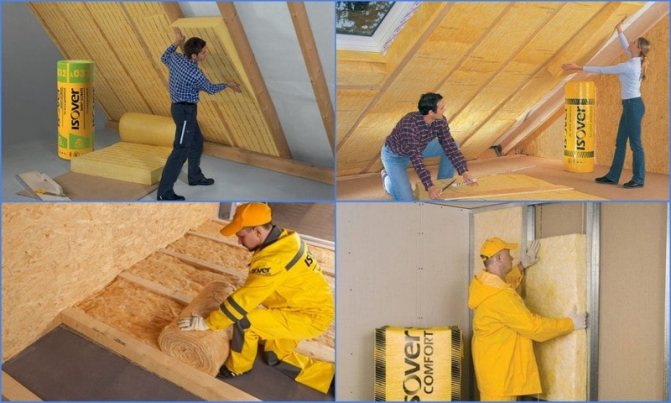

Isover laying options
Specifications
It has many advantages. Thanks to them, today it occupies a leading position among all other heat insulators. When choosing, pay attention to the following technical characteristics of Izover and a description of the insulation:
- Isover - This is a heat-insulating material, so that it has low thermal conductivity values - 0.038.
- Excellent sound insulation performance.
- For the manufacture of insulation, fiberglass was used, which is not afraid of bacterial or fungal damage. It does not lend itself to the influence of rodents and small insects.
- High moisture permeability... This indicator is a disadvantage. This is explained by the fact that the material has a porous structure.
- Low specific gravity - 13 kg / m3.Due to the low weight of mineral wool, the process of installation, transportation and loading of the material is simplified. Installation of insulation can be done by hand.
- Ecological cleanliness.
- High degree of durability from the negative effects of chemicals.
- High ductility... Mats can be compressed up to 60% and rolls up to 75%.
- Fire resistance.
Also read about the beneficial properties of Polynor sprayed insulation.
The video shows the technical characteristics of the insulation Isover:
If we talk about the size of the Izover material, then they depend on the form of release. The mat rolls can be 5.10 cm thick - single layer option. And for a two-layer layer, the thickness of one layer is 5 cm. For a roll type, the standard width is 120 cm, and the length is 7-14 cm. But the covered area can vary within 16-20 m2.
What insulation for the roof to choose and what its name is, is described in this article.
For those who want to know how to insulate the interfloor ceiling in a private house, you should follow the link.
But what kind of insulation under a ventilated facade should be used is described in this article: https://resforbuild.ru/paneli/utepliteli/dlya-ventiliruemyx-fasadov.html
Perhaps you will also be interested in knowing which insulation is better than basalt or mineral wool.
Advantages and disadvantages
The positive qualities of insulation are directly related to its physical properties; the advantages of Isover include:
- The low cost of products, which gives tangible advantages over other heaters, is widely used in individual construction for thermal insulation of residential buildings, baths, outbuildings.
- Thanks to the Multipack technology, light weight and elasticity create additional convenience during transportation, soft cotton wool in rolls is compressed during production, after unfolding it increases in volume 5-6 times and completely restores its working shape.
- The manufacturer produces an extensive line of products in a wide price range, designed for various purposes; the consumer has the opportunity to choose between a budget fiberglass and a more expensive basalt product.
- The physical properties and forms of release of mineral wool allow them to be used for thermal insulation of any complex contours and planes: pipelines of various diameters, chimneys, ventilation ducts.
- It is convenient to work with insulation, due to its low weight and form of release, it is possible to cover significant volumes with rolls or sheets in a short time. Compared to traditional glass wool, the installation speed doubles due to the fact that when laying in the frame, no additional fasteners are required.
- Mineral wool material not only provides thermal insulation, but also absorbs noise well, performing a double useful function; brands specially designed for sound protection are sold in the trade network.
- High elasticity due to advanced production technology ensures that the material does not shrink, maintaining the same thermal insulation characteristics throughout its entire service life.
In addition to many positive qualities, Isover has quite tangible disadvantages:
- Since mineral wool absorbs moisture well, it cannot be used on objects with high humidity and underground. To protect against humid air, a vapor barrier film must be placed under the insulation or the space between the shells of the thermal insulator and the object is ventilated.
- Low-cost soft mats, when laid, require a rigid frame, otherwise they deform and cease to perform thermal insulation functions.
- When laying glass wool, protective equipment should be used against fibers that negatively affect the eyes and mucous membrane of a person, irritate the skin and cause itching.
- If glass wool is taken for interior decoration, measures should be taken for its reliable sealing and isolation from the environment, otherwise small glass fibers will penetrate into the room, causing discomfort.
- Some environmentalists question the ecological purity of mineral wool, pointing out that binder resins are added during their production, which release formaldehyde, which is harmful to health, in small quantities.
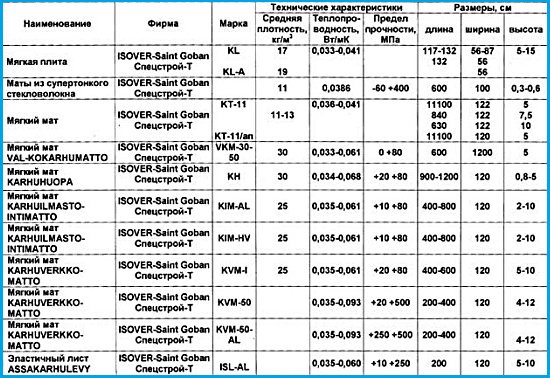

Specifications of some brands
How and from what is the ISOVER mineral insulation made | #Industrial scale
Where is Isover and its varieties used
This material has several varieties. Each of them is designed to perform specific jobs. Below we list them.
Isover KL34
Isover KL34 is available in slabs of 5 or 10 centimeters thick. They are mounted tightly on the frame; additional fasteners do not need to be used. Such plates can be used to insulate a ventilated facade and masonry, which consists of several layers. Any planes for insulation are suitable: both vertical and horizontal, and those that are inclined.
Isover KL37
Isover KL37 is supplied in tightly pressed packs. It also does not require additional fasteners during installation. This material is used to insulate floors between floors, walls, roof slopes. In this case, a tight fit of the material to the surface is necessary.
Isover KT37
Isover KT37 is available in compressed rolls. Does not require fasteners, but, like the previous material, it should fit well to the insulated plane. It is used for thermal insulation of roofs, attics, floors between floors, walls and partitions inside rooms.
Isover KT40
Isover KT40 is a two-layer material (each layer is 5 centimeters thick), which is produced in the form of tight rolls. It is used without additional fasteners for insulating surfaces located horizontally - floors and ceilings. If the cavity for filling with insulation is of insufficient depth, then the isover can be divided into two layers.
Isover STYROFOAM 300A
But such material as Isover STYROFOAM 300A requires the mandatory use of fasteners. It is produced in the form of solid rough slabs, the surface of which adheres well to concrete. The composition of this insulation includes extruded polystyrene foam, due to which insulated cells are formed.
This increases the temperature resistance and moisture resistance. This heat insulator is suitable for work on both horizontal and vertical surfaces. They insulate the outer and inner walls, floor and flat roof. You can apply plaster on top.
Video. How to insulate a plaster facade with Isover materials
Isover VENTITERM
Isover VENTITERM is a versatile insulation. It is produced in the form of rigid plates treated with a water repellent. The basis of this material is mineral wool, consisting of basalt fibers. They insulate (on one side) ventilated facades, as well as pipes for ventilation and water supply. It is also used to protect precision instruments from the cold.
Isover pitched roof
Isover pitched roof - insulation used for roof insulation. Available in slabs 61 centimeters wide and 10 or 5 centimeters thick. It practically does not absorb moisture, and also absorbs sound well. High vapor permeability and incombustibility are two more useful properties of this material. It keeps heat well, especially if you use two layers, the upper one of which covers the joints of the lower one. Important: during installation, the step of the rafter system must be done so that the insulation plates do not fall through.
Isover ventilation façade
Isover ventilation façade is no different from an ordinary Isover. It is produced in a two-layer form, due to which it keeps heat well. During installation, do not allow the insulation to lag behind the surface.
Isover sound protection
Isover sound protection is available in mats and slabs.It is able to protect the room from external sounds better than other heaters. It is used to insulate suspended ceilings and interior partitions.
Insulation marking Izover
It is quite difficult to understand the labeling that Saint-Gobain puts on its product, depending on the physical properties, the following symbolic and numerical designations are found:
- CT scan - flexible rolled mats with a density of about 15 kg / m3, are used for insulating lagged floors, interfloor and ceiling ceilings, the KT37 variety has a thermal conductivity of 0.037 W / (m • K), KT40 - 0.040 W / (m • K). The KT brand is supplied in rolls 50 or 100 mm thick, the standard length of KT37 is 6300 mm, width is 600 mm (for KT40, the dimensions are 7000x610 mm), the compression ratio of the roll is 1: 4 (the volume is 0.16 m3 in the packed state and 0.71 m3 in open).
- KL - plate heat insulator 50 or 100 mm thick with an average density of 20 kg / m3, designed for frame installation without fixing with dowels, parameters of the common brand KL34 - thermal conductivity 0.034 W / (m • K), vapor permeability - 0.53 mg / m • h • Pa, upon delivery, the package is compressed twice, the return rate after compression is 98%.
- RKL - rigid sheets, reinforced on both sides with fiberglass, with a density of 60 kg / m3 and a thermal conductivity of 0.030 W / (m • K), the RKLA type has a tongue-and-groove connection and performs the function of additional wind protection during installation.
- SKL - semi-rigid sheets with a density of 55 kg / m3 and a thermal conductivity of 0.031 W / (m • K).
- RKL-EJ - sheets of increased rigidity, mounted by the ridge method with a density of 95 kg / m3 and KT 0.031 W / (m • K).
- VKL - rigid sheets with a density of 130 kg / m3 and a thermal conductivity of 0.032 W / (m • K).
Important: From the given digital marking, it is enough for the consumer to remember that the letter T means rolled material, and the L indicates the plate, the digital designation is equal to the thermal conductivity, the lower it is, the better the product retains heat.
The Russian-language marking of Izover is often used, in which the symbol P means plates, M - roll insulation, AL (AL) - reinforced foil covering, OL - fiberglass base (glass fiber).
Varieties
Manufacturer Izover produces mineral wool in rolls, mats and slabs.
Slabs
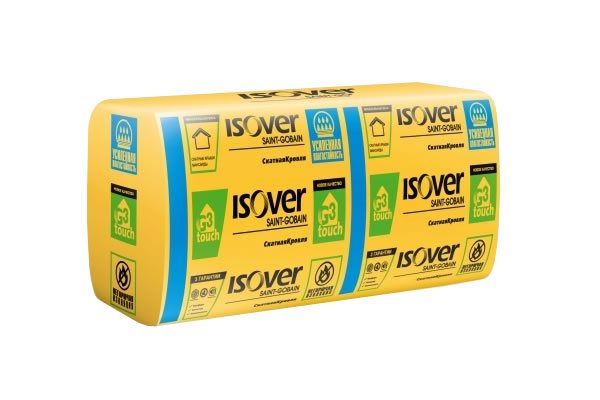

Plate models are of the following types:
- Isover Optimal, the density of which is 28-37 kg / m3. It is used for frame structures and installation of sound insulation for interior partitions and inter-floor ones. They can insulate the roof, floors, and walls. The dimensions of the slab are 60 * 100 cm, the thickness is 5 cm or 10 cm, in a package of 4 slabs (10 cm) or 8 slabs (5 cm);
- Isover Standard. It is used to insulate walls from the outside before finishing them with siding or facing bricks. The slab geometry is identical to Isover Optimal. Among the characteristics of Isover Standard, it is worth noting low compressibility under a specific load of 2 kPa - 10%;
- Isover Facade, with a density of 145 kg / m3, is used for facades with a thin plaster layer. Fire resistance, as well as the absence of the influence of rodents are the undoubted advantages of this model when insulating a building.
Rolls
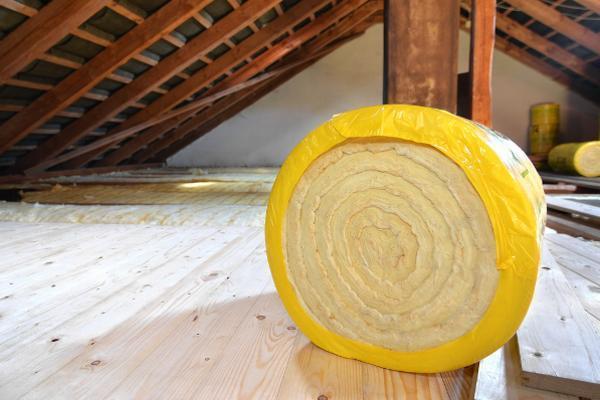

Among the many roll options of this insulation, the following can be distinguished:
- Isover Warm Roof. The technical characteristics of this model allow it to be used for pitched roofs, since this material has high water-repellent properties;
- Isover Warm House is convenient to use on large horizontal surfaces. It allows you to save 64% on heating your home;
- Isover Sauna combines a vapor barrier. The presence of a foil layer allows you to maintain a high room temperature for a long time;
- Isover Karkas-M37 is used for serial construction;
- Isover Karkas-M40-AL has a layer of aluminum foil, which makes it possible to increase the heating rate of the room and save heat for a long time;
- Isover Karkas-M40 is used for thermal insulation of floors.
Mats
Pro - used inside and outside, a versatile material that is popular. Thickness 50, 100 and 150 mm.Classic - thickness 50 mm, 2 mats are wound in a roll. It is used for insulating floors, roofs on joists, ceiling on battens. M37 frame - thickness options 40, 50, 60, 100 and 150 mm. It is used to fill the inter-wall space when insulating frame houses. M34 frame - 50 mm thick, less dense than M37. M40AL frame - foil-clad insulation 50, 100 and 150 mm thick.
Product line, application features and characteristics of Isover
Isover, based on glass and basalt fibers, is produced for various purposes, therefore, the products consist of almost three dozen items that have their own profile name depending on the object to be insulated. For a consumer who decides to purchase Isover insulation, it is useful to study its technical characteristics, get acquainted with the photo, find out the prices on the manufacturer's website, and master the installation methods.
On the market, products are marked with markings indicating their physical parameters, and are also broken down by areas of application to facilitate the choice of the buyer; when ordering a large batch, the company can supply the goods in the sizes specified by the customer.
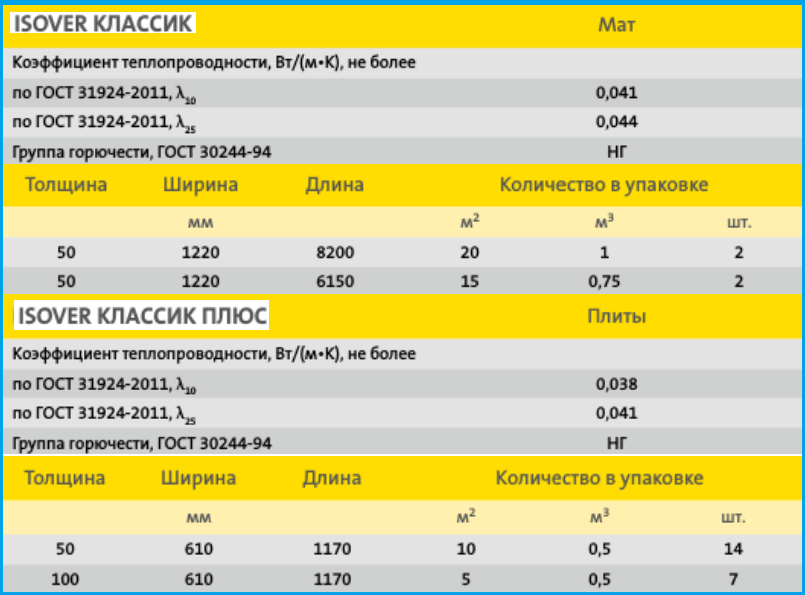

Classic series parameters
Classic
This brand of Izover on the basis of glass wool is produced in two varieties: Classic in rolls and Classic Slab, when using a product from Saint-Gobain for thermal insulation of an individual house, they achieve a reduction in heating costs of up to 65% compared to a non-insulated building.
Isover Classic parameters:
- The slab is designed for thermal insulation of external walls, ceilings and interior partitions, provides double insulation from heat loss and noise interference, the roll material is placed between the floor and attic logs.
- The CT of the slab insulator at 10 ° C is 0.038 W / (m • K), at 25 ° C - 0.41 W / (m • K), this indicator in terms of thermal insulation properties with a mineral wool thickness of 50 mm is equivalent to 950 mm of a brick wall. Rolls and mats at similar ambient temperatures have a thermal conductivity of 0.041 - 0.044 W / (m • K), respectively.
- Density: 15 kg / m3.
- Flammability according to GOST 3244-94: NG.
- Water vapor permeability: 0.55 mg / m • h • Pa.
- During installation, the sheets are placed in the frame without additional fastening, they have 100% recoverability, due to their elasticity, they tightly adjoin the frame without cold bridges.
- Standard sizes of 50 or 100 mm of sheet are 610x1170 mm, the package contains 14 or 7 pieces with a volume of 0.5 m3 and an area of 10 or 5 m2.
- Rolls are compressed 6 times, they are produced with a thickness of 50 mm with a size of 1220x6150 or 1220x8200 mm with an area of 15 or 20 m2 and a volume of 0.75 or 1 m3, respectively.


Facade series parameters
Facade
Slabs based on basalt fiber provide a high level of thermal protection of the building due to the homogeneity of the heat-shielding layer and its high mechanical strength, the Isover Facade brand has the following density and characteristics:
- Thermal conductivity: 0.036 - 0.041 W / (m • K).
- Perpendicular tensile strength: from 15 kPa, compressive strength: up to 45 kPa at 10% deformation.
- Density: 125 kg / m3.
- Flammability according to GOST 30244-96: NG.
- The Facade brand has a standard water absorption of 1 kg / m2 with partial or complete immersion in water for 24 hours.
- Packed in slabs of 60x1000 mm with a thickness of 50 or 100 mm in the amount of 4 or 2 pieces with a volume of 0.12 m3 and an area of 2.4 or 1.2 m2, respectively.
In addition to this brand, the manufacturer produces a product made of basalt fiber Isover Facade Master, which has similar characteristics and Isover Plaster Facade based on glass wool, which is the lightest base for plaster, with the following distinctive features:
- Fire hazard class KMO, flammability - NG.
- Tensile strength in the perpendicular direction relative to the front surface: from 15 kPa.
- It has a high modulus of elasticity and increased vapor permeability due to the use of the Weber therm Comfort technological development from Saint-Gobain.
- CT: 0.038 - 0.043 W / (m • K).
- Tiled insulation is supplied with a thickness of 50, 100 and 150 mm in packs of 8, 4, and 2 pieces, with an area of 5.76, 2.88, 1.44 m2, respectively, with a volume of 0.288 m3 and 0.216 m3 for sheets with a thickness of 150 mm, their standard size 600x1200 mm.
For thermal insulation of facades based on mineral wool, another brand Izover Ventfasad is produced in slabs with a standard thickness of 30 mm, dimensions 1190x1380 mm, 8 pieces in a pack with a total area of 13.14 m2 and a volume of 0.394 m3.VentFasad has a thermal conductivity of 0.032 - 0.037 W / (m • K), when custom-made it can be covered with black glass fiber on one side.


Series Standard - parameters
Standard
Isover Standard, based on basalt fiber, provides a high level of thermal protection, thanks to its high elasticity, it guarantees the absence of air pockets, during installation it is designed to be fixed to the surface with umbrella dowels, its main technical indicators are:
- CT depending on the temperature values of the medium: 0.035 - 0.039 W / (m • K).
- Flammability group: NG.
- High air permeability of the order of 80 10-6 m3 / m • C • Pa.
- Water vapor permeability: 0.3 mg / m • h • Pa.
- Basalt wool is supplied in slabs of 50 or 100 mm with dimensions of 600x1000 mm, in a pack, respectively, 8 or 4 pieces with a volume of 0.24 m3 and an area of 4.8 m2 or 2.4 m2.
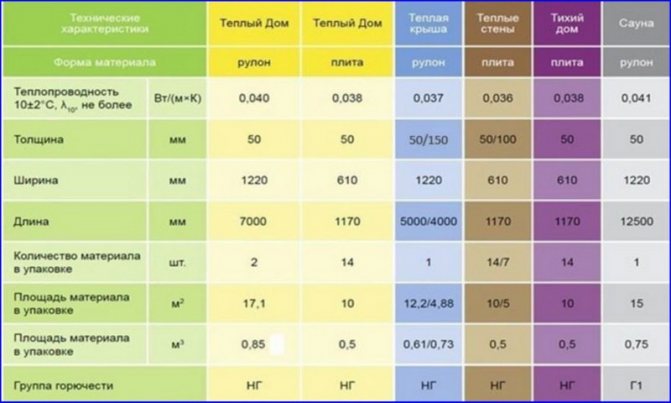

Features of Warm house and other types of Izover
Warm house
Insulation Warm House is produced in mats and is made of fiberglass, compressed 6 times, its main parameters:
- Thermal conductivity: 0.04 W / (m • K).
- Water vapor permeability: 0.55 mg / m • h • Pa.
- The thickness of the roll insulator is 50 (two mats in a pack) or 100 mm, the width is 1220 mm with the lengths of 5490 or 7000 mm, their area is 13.4, 17.1 m2 with a volume of 0.67 or 0.85 m3.
- Isover Warm House Slab has standard dimensions of slabs in a package with a thickness of 50 or 100 mm - 610x1170 mm with an area of 5 or 10 m2 and a volume of 0.5 m3.
- Water vapor permeability: 0.55 mg / m • h • Pa.
- Density 11 kg / m3.
- Flammability: class NG.
Frame house
Thermal insulator The frame house based on basalt mineral wool is designed to insulate any frame structures of external walls, partitions, pitched roofs, floors and ceilings, has good elasticity and provides additional protection against noise, its main parameters:
- Thermal conductivity: 0.038 W / (m • K) at an ambient temperature of 10 ° C.
- Tensile strength in a direction parallel to the front surface: from 4 MPa.
- Water absorption: no more than 1 kg / m2.
- Flammability: class NG.
- Packing: slabs with a thickness of 50 or 100 mm, size 600x1000, 8 or 4 pieces with an area of 4.8 or 2.4 m2 and a volume of 0.24 m3.


Frame house and Warm Roof brands - product properties
Warm Roof Master
Isover Warm Roof on the basis of basalt fiberglass is intended for insulating attics and pitched roofs, thanks to the elasticity of the slab, it retains its geometric dimensions for a long time and does not lose its physical characteristics under the influence of temperature extremes and high humidity. The main characteristics of the insulation:
- CT: 0.036 W / (m • K) at 10 ° C of the external environment.
- Tensile strength in the longitudinal direction: from 6 mPa.
- Density: 15 kg / m3.
- Compressibility under a pressure of 2000 Pa in accordance with GOST 17177-94: 25%.
- Flammability: category NG.
- Dimensions and packaging of tiles: thickness 50 or 100 mm, in a package of 8 or 4 pieces with dimensions of 600x1000 mm, an area of 4.8 or 2.4 m2 and a volume of 0.24 m3.
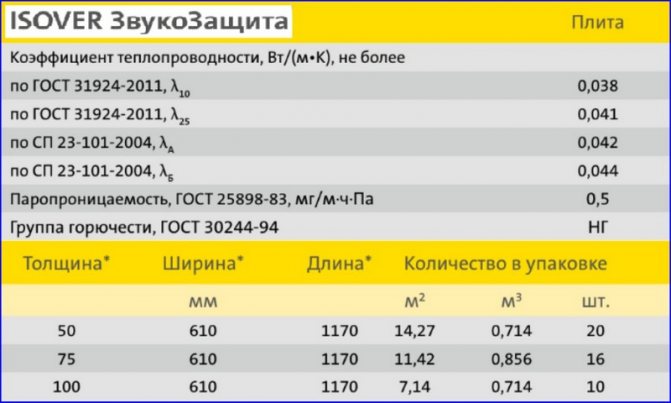

Material parameters Soundproofing
Sound protection
The ZvukoZashchita brand in the form of fiberglass-based tile elements is intended for use as sound insulation in interior partitions, ceiling ceilings and other frame-type structures, has the following features:
- Sound absorption on each side for a 75 mm thick partition, consisting of a profile metal frame for plasterboard and sheathed with plasterboard sheets of a standard thickness of 12.5 mm: 45 dB.
- Density: 15 kg / m3.
- Fire hazard class KO, flammability NG.
- Thermal conductivity coefficient: 0.038 - 0.044 W / (m • K).
- Water vapor permeability: 0.5 mg / m • h • Pa.
- Sizes of slabs: 50 (75.100) х610х1170 mm, in packs of 20, 16 and 10 pieces with an area of 14.27, 11.42 and 7.14 m2 and a volume of 0.714 or 0.856 m3.


Properties of the Profi
Pro
The roll-type Profi product is produced on the basis of fiberglass, intended for use in individual housing construction for insulating pitched roofs, external walls, frame-type partitions, has the following characteristics:
- Thermal conductivity coefficient: 0.037 - 0.042 W / (m • K).
- Density: 28 - 36.5 kg / m3.
- Water vapor permeability: 0.3 mg / m • h • Pa.
- Production form: mats or slabs, mats 50, 100, 150 mm thick, dimensions 1220x4000 (5000) mm, area 12.2, 6.1, 4.88 m2 and volume 0.61 or 0.73 m3, overall dimensions slabs 610x1000 mm.
- To facilitate cutting, the mats are marked with special markings.
Description and application
The presented material has many advantages and disadvantages of mineral wool. And this is not surprising, since their properties are quite close. It is produced in the form of plates, which can be either rigid or semi-rigid. There is also an opportunity to buy Isover in the form of rolls and mats. They are used when arranging the roof and facades of the house, ceilings, walls and floors.
Isover is based on glass fibers, the length of which reaches 100-150 microns, and the thickness is 4-5 microns. It is these parameters that allow the Isover thermal insulator to obtain high elasticity and resistance to loads. Competition can be made by the technical characteristics of the TechnoNIKOL insulation.
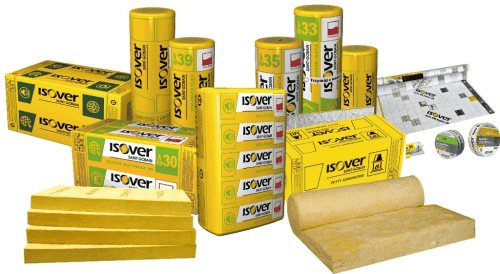

In the photo-insulation Isover
The approximate price of popular brands in the Russian market
The manufacturer Saint-Gobain supplies the domestic market with a wide range of products based on two types of mineral wool - fiberglass and rock basalt, the latter being more expensive due to its higher environmental friendliness, causing less harm to health during installation and operation.
The prices of plates and rolls differ for different suppliers of goods, usually the cost of one package is indicated, the average price for some types:
- 60 rubles for 1 m2 of a slab or roll of glass wool 50 mm thick (Warm House), the cost of a product with a thickness of 100 mm is 2 times higher;
- 85 rubles for 1 m2 of a slab of basalt wool 50 mm thick (Warm Roof series, Warm Walls, Quiet House);
- 125 rubles 1 m2 for quartz insulation with a foil vapor barrier in one roll, intended for warming saunas and baths (Warm Sauna).
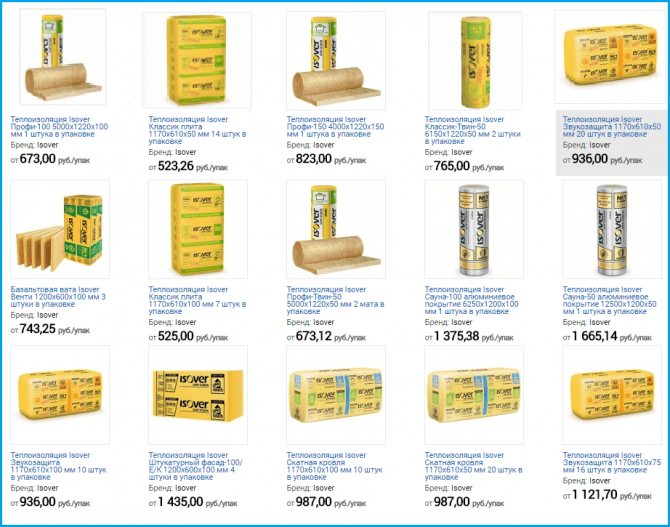

Price list for some brands
Effective thermal insulation solutions with ISOVER
Precautions at work
In accordance with safety precautions, the use of fiberglass materials requires the mandatory use of protective glasses, gauze bandages and gloves. We must definitely remember this. The use of long sleeves, trousers and socks is also important. This rule is difficult to follow in the hot season. But people who stick Isover's plates, exposing their torso, in the future greatly regret it. At first it seems that it is easy to work, and then the body begins to burn and itch. Even the shower in this case turns out to be useless. This is why you shouldn't ignore the above rule.
When working with this material, you need to stand in such a way that the bright rays of the sun fall on it.... This will allow you to see puffs of smoke.that come from him. This is fine glass dust. After installation, the insulation will not pose a danger, but during repair work it is advisable to use protective equipment. Proof of the safety of the material is the fact that Isover is even used by wasps to build nests. Yes, and sometimes mice gnaw holes in it.
To protect other living rooms from glass dust that forms during installation, it is necessary to lay a film for wall cladding between Izover and the clapboard. It could be yutavek. And even if the lining gradually crumbles, the sprayed particles will not pose a threat to you. Although if we compare Izover with glass wool of domestic production, which is not afraid of any protective barriers, then the former will obviously win in all respects. Yes, and rodents do not particularly like glass wool, unlike Izover. This also says a lot.
The lineup
Like any building material, isover insulation is available on the market in several types. Each of them is designed for specific building structures:
Isover product line
- "Sound protection" intended for finishing partitions, walls.
- For frame construction, insulation of the model "Frame».
- "Profi" used for insulation of attics and pitched roofs. This is a high quality insulation. Profi is offered on the market in rolls with a thickness of 50, 100 and 150 mm.
- Classic used by wide applications. He has access to insulation for floors, logs, attic floors and other complex objects. Although the Classic is a roll material, it can be used to cover huge areas in one go. Usually, two layers of 50 mm are laid in a roll. So you can safely split it or use it as it is.
- Classic Plus... This heat insulator insulates the outer and inner surfaces of the walls. Possesses high thermal insulation characteristics. An excellent specimen.
Important... Many models are categorized as "interchangeable". That is, one is freely replaced by another. In this regard, Profi and Classic Plus are universal heaters.
The sound protection model is increasingly used in rooms where there is a need to reduce the penetration of noise from the outside. Sound protection is two in one. Therefore, for those who do not want to hear the steps of neighbors over their heads anymore, it is recommended to install Isover Soundproofing under suspended or suspended ceiling structures.
Fiberglass construction wool from a Finnish manufacturer is today the leader in the “thermal insulation” category. Excellent quality characteristics plus affordable price for the mass consumer. This is enough to achieve the excellent qualities of a 100% insulated home.
Mineral wool insulation Isover (Isover) Venti 100
- Length (mm): 1200mm
- Width (mm): 600mm
- Density (kg / m3): 82 kg / m3
- Package area: 2.16 m2
792 rbl
Mineral wool insulation Isover (Isover) Venti 150
- Length (mm): 1200mm
- Width (mm): 600mm
- Density (kg / m3): 82 kg / m3
- Package area: 1.44 m2
775 rbl
Mineral wool insulation Isover (Isover) Light 100
- Length (mm): 1200mm
- Width (mm): 600mm
- Density (kg / m3): 38 kg / m3
- Package area: 2.88 m2
563 rbl
Mineral wool insulation Isover (Isover) Optimal 100
- Length (mm): 1200mm
- Width (mm): 600mm
- Density (kg / m3): 34 kg / m3
- Package area: 2.88 m2
117 rbl
Mineral wool insulation Isover (Isover) Optimal 50
- Length (mm): 1200mm
- Width (mm): 600mm
- Density (kg / m3): 34 kg / m3
- Package area: 5.76 m2
363 rbl
Mineral wool insulation Isover (Isover) Venti 30
- Length (mm): 1200mm
- Width (mm): 600mm
- Density (kg / m3): 103 kg / m3
- Package area: 5.76 m2
692 rbl
Mineral wool insulation Isover (Isover) Venti 50
- Length (mm): 1200mm
- Width (mm): 600mm
- Density (kg / m3): 85 kg / m3
- Package area: 4.32 m2
792 rbl
Mineral wool insulation Isover (Isover) Light 50
- Length (mm): 1200mm
- Width (mm): 600mm
- Density (kg / m3): 38 kg / m3
- Package area: 5.76 m2
563 rbl
Mineral wool insulation Isover (Isover) Facade 100
- Length (mm): 1200mm
- Width (mm): 600mm
- Density (kg / m3): 145 kg / m3
- Package area: 1.44 m2
854 rbl
Against the background of many proposals for new insulating materials, Isover Plaster Facade mineral wool and other types of Isover remain recognized as classics. Fiberglass is processed using a special patented technology to obtain insulating materials with strictly defined properties. If high adhesion to adhesives is required for external wall insulation, we recommend using Isover façade.
In addition to chemical resistance to plaster mixes, this type of material has a zero fire level. According to the area of application, Isover is divided into the following types:
- For light thermal insulation;
- For general construction insulation;
- For special purposes;
- Lightweight thermal insulation.
Almost weightless Isover mineral wool slabs exclude the load on the base. Plates are used in the reconstruction and construction of residential buildings and industrial facilities. It is a well-proven insulation material for floors, roofs, walls, attics, floors between floors. Plates are produced in optimal sizes. Thanks to this, installation time is 20% less. The specialists of our company will tell you what is better for you to buy - "Isover facade" or other products of this brand.
General construction insulation.
Fiberglass rolls "Isover" are mounted without fasteners, fit tightly to the base.They have proven to be excellent for thermal insulation of partitions, walls, floors and more. It is possible to buy Isover stone wool with an aluminum film for vaporization.
In the production of mineral wool of this class, they impart especially enhanced moisture resistance and fire safety properties. Insulation is widely used for the arrangement of pitched roofs of houses, floor insulation, insulation of water pipes and ventilation pipes. Isover sound protection is used to protect against external airborne noise. The level of protection is confirmed by acoustic tests.
Stamps
Isover thermal insulation product lines have several dozen items and are designed to solve specific problems. All of them differ in the form of delivery, thickness, density and size.
Note: since all brands have the same basis, they are interchangeable.
For general construction works
Isover Profi. A versatile material with increased elasticity. Provides the highest level of thermal insulation among the brand's retail materials.
Supplied in rolls, board thickness - 50, 100 and 150 mm. It does not require additional fasteners during installation; a raspor can be installed. Has earned positive reviews from builders.
It is used for insulation and sound protection:
- external walls inside and outside the house;
- pitched roofs;
- interfloor ceilings;
- frame walls;
- internal partitions;
- ventilated facades.
Classic. Supplied in rolls, material thickness - 50 mm. A surprise can be set.
Application area:
- insulation of suspended ceilings;
- interfloor floors - the material lies between the lags;
- attic rooms.
Izover Classic stove. The shape of the mineral wool is a slab. Size - 610 * 1170 mm, thickness 50 and 100 mm. The package contains 5 and 10 m2.
How to make insulation correctly?
In order to correctly carry out the installation on the facade of the isover insulation, you do not need special knowledge or skills, because this is not difficult and you just need to comply with the installation instructions. Doing everything according to the instructions, you will get a facade of excellent quality, and warm rooms in the house.
Installation of insulation under the ventilation facade
To begin with, the starting profile is mounted by leveling the plates and protecting them from below on the wall. Focusing on it, then the first row of the ventilation facade is laid down.
Each plate of insulation isover is first primed with an adhesive solution. Then the main part of the solution is applied, and only then press the slab against the wall.
Each subsequent row of insulation boards is laid with an offset relative to the vertical seams of the lower row. After the end of the laying of the slabs, the ventilation facade is bottom, the slabs are fixed to the wall.
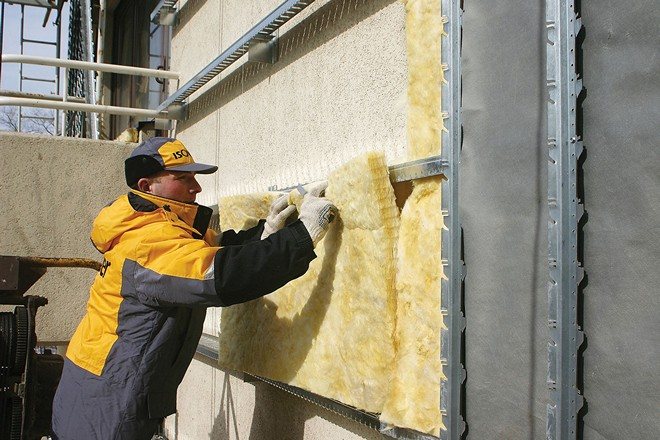

Insulation of the facade with Isover mineral wool
Installation of a plaster facade
The next stage of work is to give the surface of the insulation rigidity in order to start applying the finishing coating. For this purpose, a thin layer of glue is applied to the izover plaster facade slab, on which a plastic or steel mounting mesh is laid and rolled with a roller.
When the reinforcing layer is dry, it must be primed and covered with a layer of decorative plaster. Depending on the location of the place that was insulated, its finishing is carried out.
Types of facades Izover
Ordinary mineral wool is not suitable for insulating facades, as it is soft and easy to deform. The manufacturer has developed the Facade series specifically for external wall insulation. From above, it does not need additional finishing: the ventilation facade is covered only with reinforcing mesh and decorative plaster.
Isover Facade has all the quality certificates. It does not change the properties listed in the specification description when temperature and humidity fluctuate.
There are several types of Izover facade insulation for different purposes.One-layer insulation is mainly used for facade renovation. During construction, a two-layer insulation is used: the inner layer retains heat, and the outer one protects from the wind.
Ventilated facade Izover
Ventfasad Isover consists of two layers of insulation, which significantly increases the thermal insulation properties. It contains mineral wool and fiberglass. On one side, the slab is covered with fiberglass, so Izover Optima is not afraid of wind and mechanical stress. The slabs are fastened according to the tongue-and-groove type, so there are no gaps at the joints. It is used both in private construction and in the construction of high-rise buildings.
Ventfasad Izover niz
This type of insulation is used to decorate the interior walls of a house in combination with external insulation. Its main purpose is filling joints. Due to the elasticity of the material, the appearance of air pockets in the walls is excluded. Possesses good heat and sound insulation.
It is unacceptable to install the bottom layer of thermal insulation with a gap of more than 2 mm. This leads to the appearance of "cold bridges" and reduces the efficiency of the entire structure. Also, installation with a gap between the wall and the mineral wool slab is not allowed.
Ventfasad Izover up
Thermal insulation of this type is used to insulate the outer walls of houses in combination with an internal insulation. It has a low coefficient of thermal conductivity, which means it retains heat well in the house. Another advantage is good wind resistance, which makes it possible to use Isover Facade top in different climatic zones.
Supplied in sheets of optimal size, which reduces installation time in half, and the number of fasteners by 40%.
The upper layer slabs should overlap the joints of the lower insulation layer. Fastening is carried out with disc anchors. It is they who give the slab a snug fit to the wall surface.
